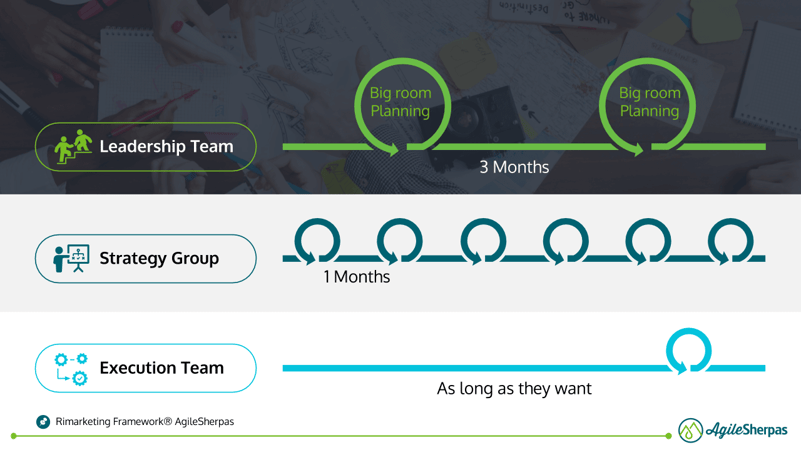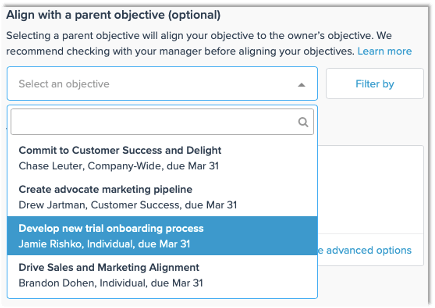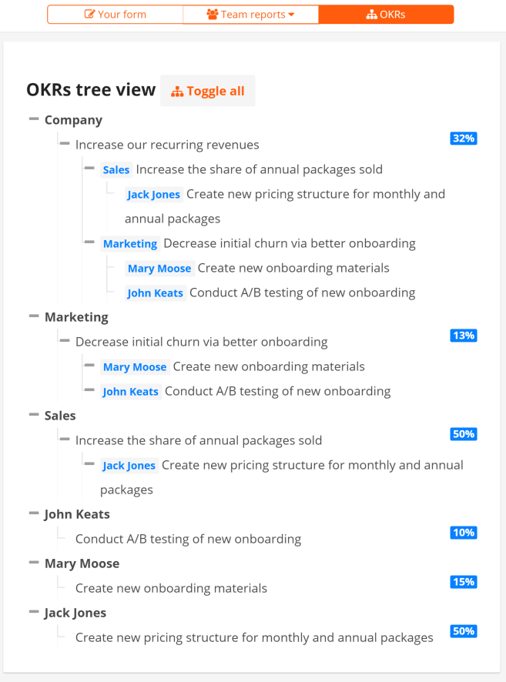Agile software development teams measure their progress by delivering useful features and functionality.
The Agile Manifesto, in fact, explicitly values “working software” as “the primary measure of progress.” But what happens when you don’t create software? How do we accurately measure the progress of other kinds of Agile teams?
Each individual team will work out their own precise success metrics, but overall Agile teams need to focus on regular value delivery. In marketing, where we can struggle to show the bottom-line impact of our daily work, this means we need to shift toward measuring marketing’s impact on business outcomes.
For marketers accustomed to tracking only their activity, this can be quite a leap, but it’s one that’s well worth taking.
Marketing Output vs. Business Outcomes
When setting up Agile marketing goals, many teams I coach confuse marketing outputs with business outcomes. However, they’re very different things. One tracks what’s being done; the other tracks whether the work that was done made a difference.
Marketing Output: the deliverables you can expect when you do marketing, such as written copy, designs, email campaigns, etc. In Agile marketing, we measure marketing output by looking at metrics such as: Cycle Time, Efficiency, and Throughput.
Business Outcomes: the impact of marketing on the business. These are much more closely aligned to customer behavior, and are often measured via Customer Acquisition Cost, Pipeline, Revenue, Customer Retention, Churn etc.
Measuring and reporting on marketing output is relatively easier for marketers. We can manually track a task’s start and end time (for Cycle Time), its waiting time (to compute Efficiency), and the number of completed items (for Throughput) on a spreadsheet. Most Agile marketing tools have the data available and could even automate the reporting for you.
However, measuring the impact of marketing on the business is a whole different story with many potential failure points.
Business Impacts Across the Marketing Function
When setting up Agile marketing goals at the execution level, some teams aren’t even aware of what their business goals are for the quarter, let alone how to measure marketing’s impact on those business goals.
Other times they might depend on IT or business analysts to generate those insights for them (which is a separate problem for another post).
At the strategy level, team leads often struggle to translate marketing goals into measurable and actionable objectives with clear Key Performance Indicators (KPIs) for their teams. Or they may pick individual or manager-level goals instead of team goals.
This becomes problematic when it encourages more individualistic behavior and undermines the team-first mentality that’s central to Agile marketing.
Last, at the marketing leadership level, it’s not clear how the marketing strategy drives business outcomes. Another common mistake I see is that leaders’ goals don’t align with their team goals, and are not tied to compensation plans.
Design drives behavior, and that goes for goals as well as systems.
Start with Strategic Agile Planning
To ensure marketing goals are in sync not just within the marketing function but across the organization, we need to change the way we think about strategic planning.

Strategic Agile planning typically starts with the marketing leadership team getting together and planning for the quarter ahead.
In a galaxy far, far away (i.e, pre-COVID days), that meeting was also known as Big Room Planning (or BRP). During BRP multiple teams fly to get together in the same physical location for multiple days. There, they share upcoming quarterly plans, strategize on big whiteboards, and agree on strategic marketing goals.
In today’s post-COVID world, we often see teams holding Big Zoom Planning meetings (or BZP), using a myriad of visual collaboration tools such as Google’s Jamboard and Miro.
Regardless if you choose to run this meeting on-site or remote, a typical outcome for such a meeting is a list of strategic marketing goals that the organization wants to deliver for the quarter. For example: launch a new product line, re-design the website, optimize online conversion, etc.
Moving From Marketing Goals to Execution
Once the marketing leadership has set strategic objectives, getting the rest of the marketing organization aligned is sometimes very difficult.
Whether using top-down, bottom-up, or a negotiation approach, making sure that the rest of the marketing organization is aligned is essential.
The marketing leadership then communicates the same strategic goals to their Marketing Owners, who are tasked with translating the strategic goals to OKRs (Objectives and Key Results) with their teams.
This is typically a monthly meeting with team check-ins against OKRs.
One of the common mistakes I see marketing managers make at this stage is taking the strategic objectives and coming up with manager goals or, even worse, assigning individual goals with no alignment to team goals.
Remember, Agile is all about the team. The leadership gets to decide on the WHAT to deliver and the team comes up with the HOW to deliver, as well as how to measure success. Of course, this validated with leadership at the end.
The last part of this Agile planning cycle is of course the marketing execution team.
After working with the Marketing Owner to create user stories, refine their backlog, and prioritize the work, the marketers get together as often as needed (daily standups, marketing demos, retrospectives and other Agile marketing ceremonies) to deliver and report on their progress.
Strategic Agile Planning – Key Takeaways:
- Create (and stick to) goals to move from order takers to empowered marketing teams
- Focus on marketing team objectives
- Marketing Owners need to turn the marketing strategy into objectives their team can execute against
Agile + OKRs = Peanut Butter & Jelly
“Create a solid strategy” or “set good marketing goals” are worthwhile things to shoot for. However, without a structure to guide us many of us will create targets that are unclear, unachievable, and/or unmeasurable. To help avoid all those issues, I’m a huge fan of OKRs (Objectives and Key Results).
OKRs is a framework that helps you move from just looking at the output, or a list of marketing tasks, to more impactful business outcome-focused metrics.
For example, Agile marketing teams often become too focused on the minute details of marketing, be that writing copy, building an email campaign, or other task-based work.
OKRs, which are tied to deeper business results, urge the marketing team to take a step back. As a result, they can get out of their main functional area, learn about customers, and ask why certain decisions are being made.
The blend of OKRs and Agile marketing is about taking a successful marketing process and making it even more outcome-driven.
Bottom-Up or Top-Down?
I get this question all the time: Do you define OKRs as bottom-up or top-down? The answer is you can do both – and many marketing teams do. There’s no right or wrong.
In some cases, the CMO outlines the company OKRs first, asking Marketing Owners to set their marketing goals based on that. Other times, marketing teams have to come up with suggestions for their next quarter’s objectives. In both cases, you come together at the team level to iterate on ideas, add, delete, or modify some of them.
The exact mechanics aren’t nearly as important as going through the process of setting and aligning on goals.
| First Metric |
Second Metric |
Third Metric |
|
| Overall Marketing Program |
MarketingQualified Accounts | Pipeline ($$$) | Revenue |
| Brand Marketing | Customer Satisfaction(NPS/ CSAT) | Revenue Growth | Marketing Tactic ROI |
| Performance Marketing |
MarketingQualified Accounts | Cost Per Lead/ Opportunity/ ROAS | Sales Effectiveness
(Velocity) |
Example of Marketing & Sales Alignment using OKRs
Optional: Automate with OKR Tools
Whether created bottom-up or top-down, you want to start linking your marketing goals (objectives) as soon as possible. While you can use a simple spreadsheet to do that, a plethora of OKR tools let you automate the process.

Parent-Child marketing objectives in 15Five
As you can see, each parent objective from the marketing leadership now has its child objectives for the marketing team listed as key results under it. To note accountability, the Marketing Owner is listed in front of the key result.
This is magical because higher-level marketing objectives can have their progress compiled from all the lower-level marketing tasks being done.
To get all the marketers in your team working as one, they all should share an aligned hierarchical tree of objectives and key results. The more visible, transparent, and up to date the tree is, the better it works.

OKRs tree view in Weekdone
Measure (and Prove) Business Outcomes with Agile + OKRs
Agile marketing and OKRs work best in tandem. There’s a desired end state of marketing goals, and those help keep you focused. Agile marketing is the process that gets you there, as tracked with key results.
Agile ways of working overlap well with OKRs. Together, they allow marketers to retain strategic focus and align end priorities with daily marketing execution.



